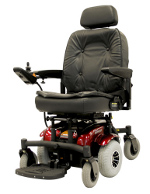The Wheelchair Guide
Your Wheelchair and Mobility Scooter Resource
Electric Wheelchairs for Seniors
Thursday, May 21st, 2009 at 4:27 pm
 Electric wheelchairs, which are often also called power chairs, offer the advantage of a manual wheelchair, in that they are very maneuverable. However, unlike manual wheelchairs, power chairs are powered electronically, so they can typically be operated very easily, requiring very little physical activity of the senior.
Electric wheelchairs, which are often also called power chairs, offer the advantage of a manual wheelchair, in that they are very maneuverable. However, unlike manual wheelchairs, power chairs are powered electronically, so they can typically be operated very easily, requiring very little physical activity of the senior.
A simple joystick control scheme is most popular for controlling electric wheelchairs, which allows the senior to simply push the joystick. The joystick, which is attached to the arm of the power chair, then moves the wheelchair in the direction they wish to travel. Of course, there are a number of alternate wheelchair control systems available as well, including breath controlled systems and remote controlled systems, which are often used by caretakers.
A Brief Background on Electric Wheelchairs
The first electric wheelchairs, which were developed in the early 1950′s, were simply adapted E & J manual wheelchairs.
An electric motor was attached to the manual wheelchair, which was controlled using a simple joystick control scheme, although even during the 1950′s, researchers were already coming up with alternate control schemes. One popular method was to mount something similar to a joystick near the individuals head. They could then use their face to control the electric wheelchair.
The Modern Electric Wheelchair
Today, while some portable electric wheelchairs do use a traditional steel tubed folding wheelchair design, most look much different from a traditional manual wheelchair. Instead, an electric motor and battery is contained in the base of the wheelchair, usually covered by molded plastic.
A captains chair, which, depending on the cost of the power chair, often rivals that of most office chairs, both in comfort and durability, is mounted on the base of the wheelchair. The captains chair often reclines and swivels, to facilitate comfort and make transferring into and out of the wheelchair easier. Some even include an electric lifting system to raise and lower the chair.
While many power chairs share a similar design, one way they are often classified is by their wheels. A mid-wheel power chair features one set of large wheels in the middle of the base and one set of smaller wheels on the front and back of the base. The larger wheels are what does all of the work and are powered by the electric motor. The smaller set of wheels on either side of the drive wheels, provide extra support and stability.
The mid-wheel electric wheelchair offers the advantage of excellent maneuverability. It can turn in much smaller spaces. However, in some cases it might not offer the same stability as a rear-wheel drive wheelchair. This is because the center of balance for a mid-wheel wheelchair is in the middle of the power chairs base.
The other common type of electric power chair is the rear wheel drive wheelchair. These feature a set of rear wheels, which depending on the model might be slightly larger, and a set of front wheels, giving it four wheels in total. The rear wheels, are powered and what actually moves the power chair.
The rear wheel drive wheelchair does not offer the same maneuverability that a mid-wheel power chair does, but does offer increased stability. This is because the weight of the occupant is more evenly distributed across the base, making a wider center of balance.
As is the case with manual wheelchairs, power chairs, both mid-wheel and rear wheel drive models, include anti-tip casters to prevent the wheelchair from tipping over backwards.
Advantages of Electric Wheelchairs
One of the major advantages that an electric wheelchair offers is that it does not require much effort to use. Simply push the joystick and the power chair will move, with many offer very small turning radius and sensitive controls. The speed is often adjustable and some models can reach speeds of over 10 miles per hour.
The range of a power chair varies, but most can travel at least 5 miles without requring a recharge. Some can travel upwards of 20 or 30 miles per charge, but this often is dependent on the terrain and weight of the occupant. For example, if you decided to drive around the hills of San Fransisco, the battery would wear down much quicker than it would when used on flat land.
Along the same lines, if the rider weighed 300 pounds, the battery would wear down quicker than if they weighed 150 pounds. Often, an extra battery pack is purchased for those who use the power chair continuously, as this way when one battery pack wears down, it can be removed and charged, and the fresh battery pack used.
Electric Wheelchairs and Seniors
While the electric power chair can be an excellent device, especially for seniors, it is often cost prohibitive.
Of the three main mobility options, manual wheelchairs, electric wheelchairs, and mobility scooters, electric wheelchairs are by far the most expensive. When compared to mobility scooters, electric wheelchairs often also have a lower range, lower top speed, and are not as well suited to rough terrain. However, for indoor use, they are usually superior to scooters.